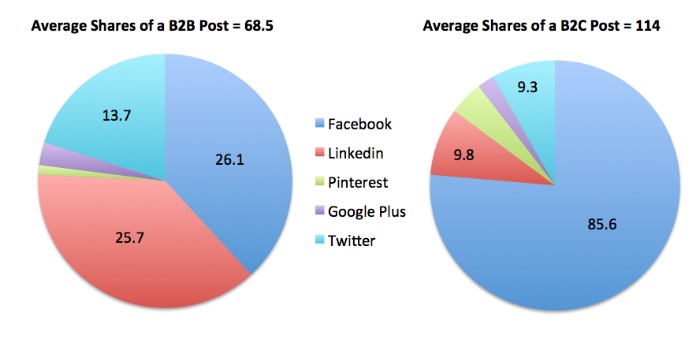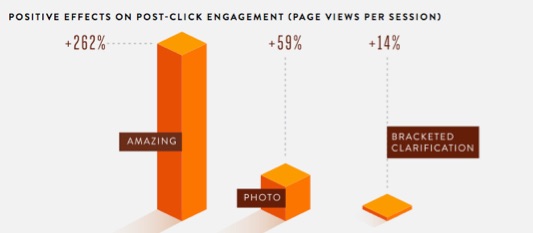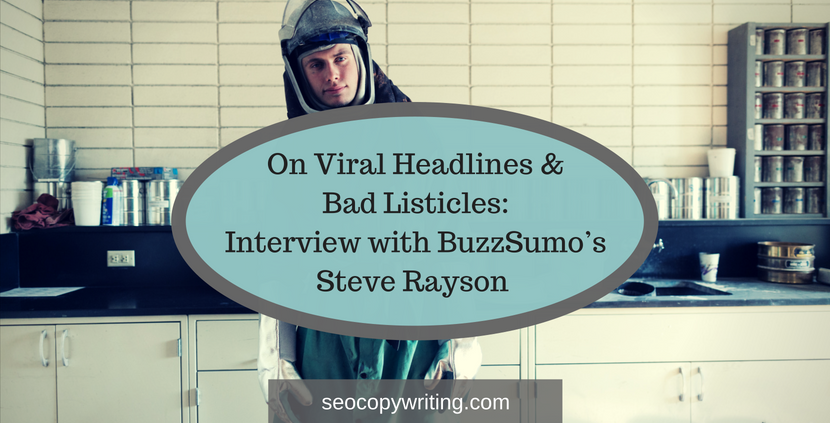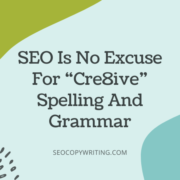On Viral Headlines & Bad Listicles: Interview with BuzzSumo’s Steve Rayson
 Since our first interview with Steve Rayson in June 2015 — and only two years after he and co-directors James Blackwell and Henley Wing launched BuzzSumo — the SaaS company has grown by quantum leaps to become a leading content data and analytics platform. And it shows no signs of slowing down.
Since our first interview with Steve Rayson in June 2015 — and only two years after he and co-directors James Blackwell and Henley Wing launched BuzzSumo — the SaaS company has grown by quantum leaps to become a leading content data and analytics platform. And it shows no signs of slowing down.
Nor does Steve, for that matter. We caught up with him to ask about his latest article sharing his insights into viral headlines, which closely parallels his year-end analysis of 2015’s most-shared content. (If you read through all that Steve has researched and published over the past year, you’ll appreciate just how busy he’s been). Enjoy!
In your recent BuzzSumo article reporting on the findings from your research into viral headlines, you break down the viral headline structure into five common elements: Is there one that is absolutely essential to a “clickable” headline?
I don’t think there is a single element. I think if I had to point to the most important element I would probably say the clarity of the promise is key: What will I get if I click through to your content?
I think one of the interesting aspects was how the performance of headlines varied so much from network to network. See the top three word phrases (headline trigrams) across FB and Twitter as an example. So you do have to craft different text when promoting content on the different social networks.

BuzzSumo just released research findings from its joint study with HubSpot on B2B vs. B2C content performance across all the major social networks. Did you find any surprises that relate to your viral headline study?
Not that relate to viral headlines per se, but I think it is interesting to see the importance of Facebook to B2B sharing. Whilst I understand the focus on LinkedIn, I think B2B marketers should not ignore Facebook as it seems to be growing in importance.
 In discussing how well list and “how to” content formats perform across all social networks, you express reluctance in sharing your findings for fear that the web will be saturated with them – particularly in B2B marketing. Why are you especially concerned about B2B?
In discussing how well list and “how to” content formats perform across all social networks, you express reluctance in sharing your findings for fear that the web will be saturated with them – particularly in B2B marketing. Why are you especially concerned about B2B?
One concern is simply that we will see the same headlines again and again as people are lazy. My other concern is the appallingly poor quality of many list posts — I mean really poor.
For example, today I clicked to read a post on ‘10 Tips for a Successful Product Launch’. The post was one of those short list posts that add zero value. The advice recommended was that you should:
- Plan
- Set measurable goals
- Launch a product your customers need
- Define your key message
- Beta test your product
- Etc.
You get the idea. It is just a list almost anyone could sit down and write, but it is actually not helpful.
In fact, it is worse than not helpful as it wasted my time. I get frustrated when I click through to these posts. So much so that I am actually developing an app which uses a combination of algorithms and human filtering to suggest helpful or valuable content so you don’t waste time on these types of list posts.
This sounds similar to what Google does with its Panda algorithm and Search Quality Raters guidelines. Is this the case? Will the app be integrated into the existing BuzzSumo platform or will it stand alone as its own set of search returns?
It is called Anders Pink (B2B Marketing) and is separate from BuzzSumo. In essence, you set up an Anders Pink stream and our algorithm filters content for your team.
You can add RSS feeds, content shared by influencers or published by specific sites. For all of them you can filter by keywords; for example, “only show content shared by these 10 influencers about influencer marketing”. Then your team can rate, flag and comment on new content, so you can further filter it by the most highly rated by your team and ignore the rest.
So in the wider scheme of marketing things, what overall headline creation and content sharing strategies would you suggest?
Headlines matter and you can increase shares by adopting the viral content elements and structure in your headline that I outlined in my blog post.
That said, I think you have to research and test what works in your area. As I always say, you need to be clear about your amplification strategy before you write content: who will share or link to the content, and why?
You also need to spend as much time on amplifying your content as creating it.
Finally, findings from a study of 3 million paid link headline click-through rates conducted by HubSpot and Outbrain (Data Driven Strategies for Writing Effective Titles & Headlines) seem to contradict BuzzSumo’s. Specifically, they report that headlines with the words “how to” and “amazing” all hurt CTRs by as much as 59 percent. What do you make of that? Is it merely a difference between “clicks” and “shares”? Or does it have to with the nature of the headlines studied?
This Outbrain study from 2013-14 was very different and was about the clicks through from headlines on Outbrain promoted content. Thus it was not about content headlines per se but the adverts that promote content.
I think this explains some of the differences but it is mainly about a different context. The Outbrain study is about Outbrain-promoted content and the headlines they use to get people to click through to a promoted article. Its headlines are the featured posts you see at the bottom of an article on say “Time” or a major publisher, as shown in the image below. This example is typical — the 4 ‘around the web’ stories are from Outbrain.
 Thus Outbrain-promoted headlines occur in the context of an article someone is reading on a major publisher.
Thus Outbrain-promoted headlines occur in the context of an article someone is reading on a major publisher.
What are people looking for at the end of an article on say Time? I think it is very unlikely to be a tip or a how to post. Thus you wouldn’t be surprised to see ‘how to’ posts perform badly in this context. However, if you were on LinkedIn or a social site and browsing for ideas on how to improve performance, you are probably going to be much more interested in a ‘how to’ post.
So context to me plays an important role and explains the differences, I suspect. If you look at the article from Time on the Federal Reserve as an example, at the bottom OutBrain are promoting a set of articles that are not relevant to the post.
Personally I don’t like these article placements, but people say they work as you can get your content exposed on major publications.
So the Outbrain survey is very specific; it is not about article headlines but the headlines used in these article promotions. I don’t think this is typically how people find content, particularly when it comes to B2B content. I can see how entertaining content may work better.
And yes, the Outbrain survey was on click-throughs to articles while our focus of course was on the articles people shared, i.e., they were engaged with the content or felt it had enough value to share the post. There is a big difference between what motivates me to click through to an article advertised on Time and what motivates me to share with my audience. So you can’t really compare.
That said, Outbrain actually found “When used in the headline, the words ‘amazing’ and ‘photo’ increase page views per session”. This is consistent with our findings about these terms when it comes to engagement and shares.

OutBrain says “while ‘amazing’ may only attract a small audience, this is an audience that continues to be highly engaged.” Thus it seems to me that this is consistent, that this highly engaged audience is more likely to share the content.
I hope this explains my views.
Abundantly, thank you! And thank you for sharing your time with us, Steve. :)
Connect with Steve on Twitter and LinkedIn
Photo thanks: Phoebus87 at English Wikipedia, CC BY-SA 3.0, Wikimedia.org








Trackbacks & Pingbacks
[…] On Viral Headlines & Bad Listicles, seocopywriting.com […]
Leave a Reply
Want to join the discussion?Feel free to contribute!